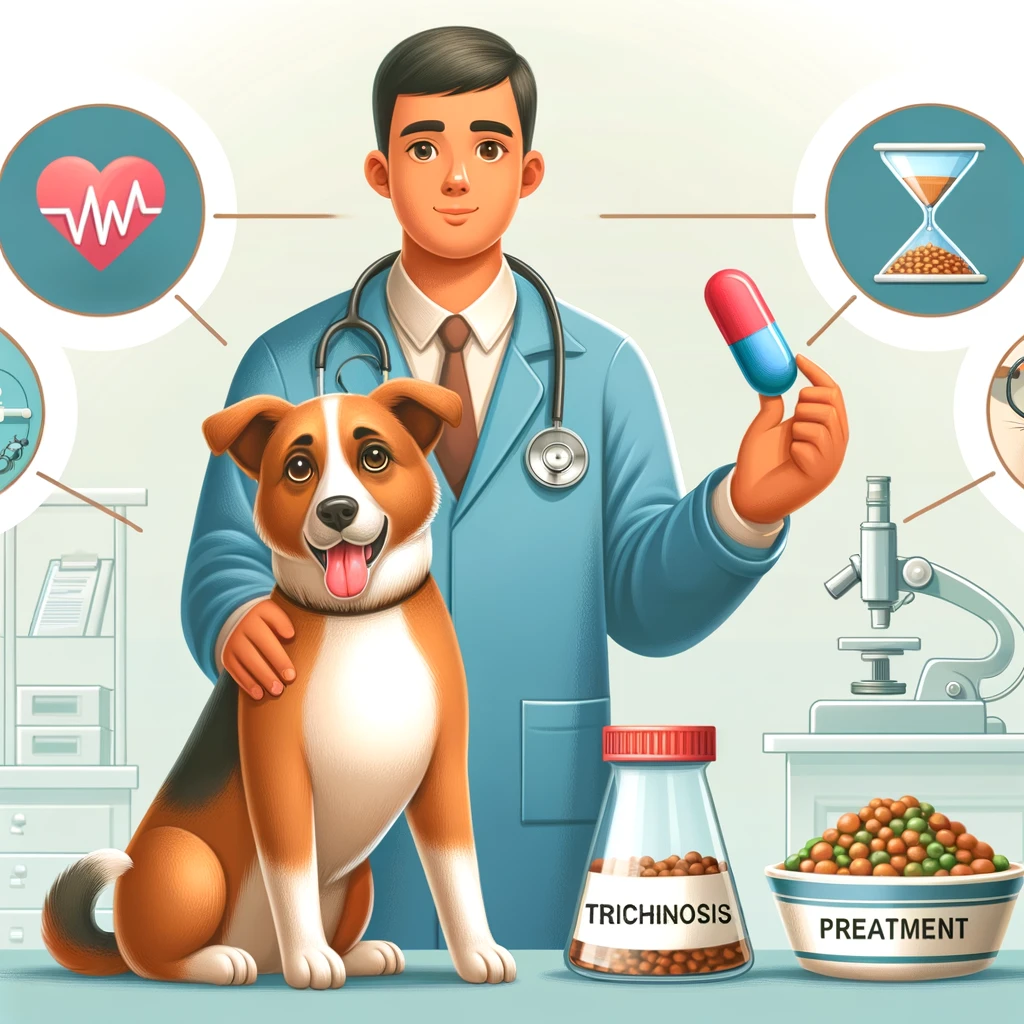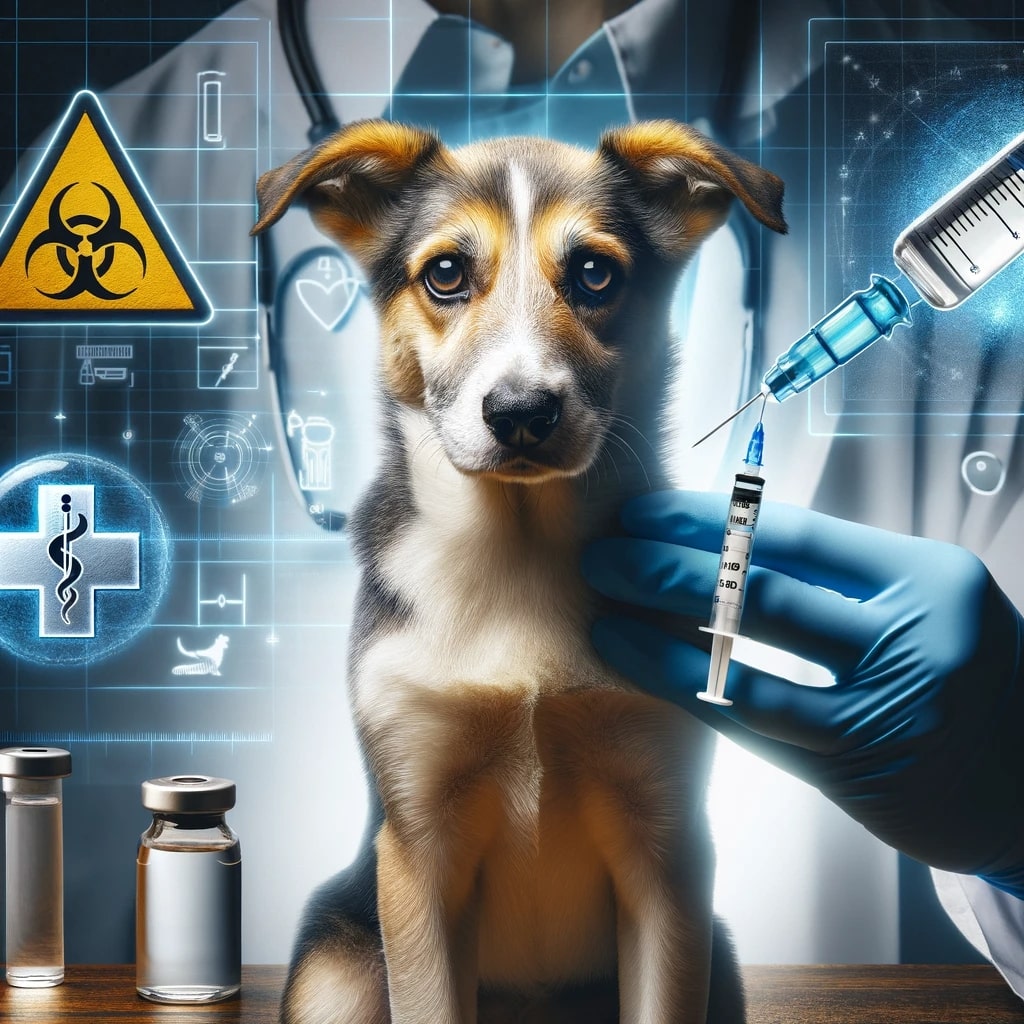What is Trichinosis and How Does it Affect Dogs?
Trichinosis, also known as trichinellosis, is a parasitic disease caused by roundworms of the Trichinella genus. It’s important for dog owners to understand this condition as it not only affects dogs but can also pose a risk to humans. The disease is contracted by consuming raw or undercooked meat infected with Trichinella larvae. In dogs, trichinosis can lead to a range of symptoms depending on the severity of the infection.
Symptoms of Trichinosis in Dogs
Dogs with trichinosis may exhibit symptoms such as:
- Gastrointestinal issues like vomiting or diarrhea
- Muscle soreness or stiffness
- Weakness or lethargy
- Fever
- Inflammation of the muscles
Diagnosis and Treatment
Diagnosing trichinosis involves a combination of blood tests, muscle biopsies, and clinical signs. Treatment typically includes:
- Antiparasitic medications
- Supportive care for symptoms
- Dietary adjustments
Prevention Tips
Preventing trichinosis is crucial and includes:
- Avoiding feeding raw or undercooked meat to dogs
- Ensuring good hygiene practices
- Regular veterinary check-ups
By understanding trichinosis, dog owners can take proactive steps to protect their pets and their family from this parasitic disease.
How is Trichinosis Transmitted to Dogs?
The transmission of trichinosis in dogs primarily occurs through the consumption of raw or undercooked meat containing Trichinella larvae. The lifecycle of the Trichinella worm is complex, and understanding it is key to preventing transmission.
Lifecycle of Trichinella Worm
- Ingestion: Dogs ingest infected meat.
- Larvae Release: Larvae are released in the dog’s stomach and migrate to the intestine.
- Adult Worms: Larvae develop into adult worms and reproduce.
- Migration: New larvae migrate through the bloodstream to muscles.
- Encystment: Larvae encyst in muscle tissues.
Common Sources of Infection
- Wild game or scavenged meat
- Infected rodents or wildlife
- Uncooked scraps from infected animals
Controlling Transmission
- Avoid feeding raw or undercooked meat to dogs
- Monitor dogs to prevent them from scavenging
- Proper cooking and handling of meat
Understanding the transmission pathways of trichinosis helps in implementing effective preventive measures to keep dogs safe from this parasitic infection.
What are the Signs and Symptoms of Trichinosis in Dogs?
Recognizing the signs and symptoms of trichinosis in dogs is crucial for timely diagnosis and treatment. The severity of symptoms can vary, ranging from mild to severe, depending on the infection’s intensity.
Early Signs
- Gastrointestinal distress like diarrhea or vomiting
- Loss of appetite
- Lethargy
Advanced Symptoms
- High fever
- Muscle pain and stiffness
- Swelling of the face or limbs
- Difficulty breathing if the diaphragm is affected
- Coordination problems
Symptom Timeline
- Initial symptoms: Within 1-2 days post-infection
- Advanced symptoms: After 1-2 weeks
When to See a Vet
- Persistent gastrointestinal issues
- Unexplained muscle soreness or weakness
- Any combination of the above symptoms
Early detection and treatment of trichinosis can significantly improve the prognosis for affected dogs. Owners should be vigilant and seek veterinary care if they suspect trichinosis.
How is Trichinosis Diagnosed in Dogs?
Diagnosing trichinosis in dogs involves a combination of clinical examination, history, and specific tests. Due to the nature of the disease, a definitive diagnosis can be challenging and requires a thorough approach.
Clinical Examination
- Assessment of symptoms
- Physical examination for muscle tenderness
History
- Dietary history, focusing on meat consumption
- Potential exposure to infected meat or wildlife
Diagnostic Tests
- Blood Tests: Detect antibodies or muscle enzymes.
- Muscle Biopsy: Confirms the presence of larvae.
- Imaging Tests: Identify muscle inflammation.
Differential Diagnosis
Trichinosis symptoms can mimic other conditions, so vets may rule out diseases like:
- Muscular dystrophy
- Other parasitic infections
- Poisoning
Importance of Accurate Diagnosis
An accurate diagnosis is crucial for effective treatment and preventing further spread, especially in households with multiple pets or where there’s a risk of human transmission.
What Treatments are Available for Trichinosis in Dogs?
Treatment for trichinosis in dogs aims to eliminate the parasite and manage symptoms. It’s important to start treatment as soon as possible to reduce the severity of the infection.
Antiparasitic Medication
- Fenbendazole: Commonly used to treat trichinosis.
- Mebendazole: Another effective option.
- Steroids: May be used to reduce inflammation.
Supportive Care
- Pain Management: Medications to alleviate muscle pain.
- Nutritional Support: High-quality diet to support recovery.
- Hydration: Ensuring adequate fluid intake.
Follow-Up Care
- Regular veterinary check-ups to monitor recovery.
- Repeat blood tests to assess the effectiveness of treatment.
Prognosis
- Early treatment can lead to a good prognosis.
- Advanced cases may have a more guarded outlook.
Preventing Reinfection
- Continued avoidance of raw or undercooked meat.
- Monitoring for any recurrence of symptoms.
Effective treatment of trichinosis in dogs requires a combination of targeted antiparasitic therapy and supportive care to manage symptoms and promote recovery.
Can Trichinosis in Dogs be Prevented?
Preventing trichinosis in dogs is primarily focused on controlling their exposure to the parasite. This involves several key strategies:
Dietary Precautions
- Avoid feeding raw or undercooked meat.
- Ensure all meat is cooked to safe temperatures.
Environmental Management
- Secure garbage and compost to discourage scavenging.
- Supervise outdoor activities to prevent consumption of wild animals or carrion.
Regular Veterinary Care
- Regular check-ups for early detection of any health issues.
- Discussing preventive measures with a vet.
Education and Awareness
- Understanding the risks associated with feeding raw diets.
- Being aware of the signs and symptoms of trichinosis.
Through these preventive measures, the risk of trichinosis in dogs can be significantly reduced, ensuring their health and safety.
What are the Long-Term Effects of Trichinosis in Dogs?
The long-term effects of trichinosis in dogs depend on the severity of the infection and how quickly it was treated. In some cases, trichinosis can have lasting impacts:
Potential Long-Term Effects
- Chronic muscle pain or weakness.
- Persistent digestive issues.
- Potential for heart or respiratory problems if major organs were affected.
Managing Chronic Conditions
- Ongoing medication for pain or other symptoms.
- Regular veterinary visits for monitoring.
- Adjustments in diet and exercise.
Impact on Quality of Life
- Some dogs may experience reduced physical activity.
- Regular management may be required for chronic symptoms.
Understanding the potential long-term effects of trichinosis helps in providing the necessary care and support for dogs that have recovered from this infection.
Are Certain Dog Breeds More Susceptible to Trichinosis?
While trichinosis can affect any dog that consumes infected meat, certain factors may influence susceptibility:
Breed Considerations
- There is no specific breed predisposition to trichinosis.
- Susceptibility is more related to diet and environment.
Risk Factors
- Dogs fed raw diets are at higher risk.
- Hunting dogs or those with access to wildlife may have increased exposure.
Breed-Specific Health Considerations
- Some breeds may have conditions that can be exacerbated by trichinosis.
- Discuss breed-specific risks with a vet.
Understanding that trichinosis risk is more about lifestyle and diet rather than breed helps in implementing effective prevention strategies for all dogs.
How Does Trichinosis in Dogs Affect Human Health?
Trichinosis in dogs has implications for human health, as the disease can be zoonotic:
Zoonotic Potential
- Humans can contract trichinosis by consuming infected meat, not directly from dogs.
- Dogs can act as indicators of environmental contamination.
Public Health Considerations
- Safe meat handling and cooking practices are crucial.
- Awareness of trichinosis symptoms in both dogs and humans.
Preventing Cross-Contamination
- Good hygiene practices when handling dog food.
- Regular veterinary check-ups for dogs.
Understanding the connection between trichinosis in dogs and human health is important for preventing transmission and ensuring the health of both pets and their owners.
What Research is Being Conducted on Trichinosis in Dogs?
Ongoing research on trichinosis in dogs aims to improve understanding, prevention, and treatment:
Areas of Research
- Development of more effective treatments.
- Better diagnostic methods.
- Understanding the epidemiology of the disease.
Collaborative Efforts
- Veterinary researchers working alongside human medical researchers.
- Studies on the lifecycle of the Trichinella parasite.
Future Implications
- Improved preventive measures.
- Enhanced public health strategies.
- Better outcomes for infected dogs.
Staying informed about the latest research on trichinosis can help dog owners and veterinarians make informed decisions about care and prevention.
How to Care for a Dog Recovering from Trichinosis?
Caring for a dog recovering from trichinosis involves a comprehensive approach that focuses on supporting their overall health and well-being during the recovery process.
Post-Treatment Care
- Follow-Up Visits: Regular check-ups to monitor recovery.
- Medication Adherence: Ensuring all prescribed medications are administered as directed.
Nutritional Support
- Balanced Diet: High-quality, easily digestible food to aid recovery.
- Hydration: Ensuring the dog stays well-hydrated.
Rest and Activity
- Gradual Exercise: Slowly reintroducing physical activity as the dog regains strength.
- Rest: Providing a comfortable resting area to facilitate healing.
Monitoring for Complications
- Watching for signs of relapse or worsening symptoms.
- Immediate veterinary consultation if new issues arise.
Emotional Support
- Regular interaction and gentle care to boost the dog’s morale.
- Maintaining a calm and stress-free environment.
Providing attentive and compassionate care is key to helping a dog recover fully from trichinosis and return to its normal, healthy life.
What Are the New Developments in Trichinosis Treatment for Dogs?
Staying informed about the latest developments in the treatment of trichinosis in dogs can greatly benefit both veterinarians and pet owners. Recent advances focus on improving efficacy, reducing side effects, and enhancing the overall well-being of infected dogs.
Advances in Medications
- New Antiparasitic Drugs: Research into more effective and less toxic options.
- Improved Drug Formulations: Making medications easier to administer and more palatable for dogs.
Diagnostic Technology
- Enhanced Testing Methods: More accurate and faster detection of Trichinella infection.
- Non-Invasive Techniques: Development of less invasive testing methods for early diagnosis.
Holistic and Supportive Therapies
- Nutritional Supplements: To aid recovery and boost the immune system.
- Physical Therapy: Assisting dogs with muscle recovery post-infection.
Preventive Strategies
- Vaccine Research: Exploring the possibility of a vaccine against Trichinella.
- Public Awareness Campaigns: Educating dog owners about prevention and early detection.
Collaboration with Human Medicine
- One Health Approach: Collaboration between veterinary and human medical research to find solutions beneficial to both dogs and humans.
Keeping up-to-date with these developments can help in providing the best possible care for dogs affected by trichinosis and in preventing future cases.
Summary Table
| Aspect | Details |
| What is Trichinosis | A parasitic disease caused by the Trichinella roundworm, affecting dogs that consume raw or undercooked infected meat. |
| Symptoms | Gastrointestinal issues, muscle soreness, weakness, fever, inflammation. |
| Transmission | Mainly through consumption of infected meat. |
| Diagnosis | Blood tests, muscle biopsies, clinical signs. |
| Treatment | Antiparasitic medications, supportive care, dietary adjustments. |
| Prevention | Avoid raw/undercooked meat, good hygiene, regular vet check-ups. |
| Long-Term Effects | Chronic muscle pain, digestive issues, potential heart/respiratory problems. |
| Susceptible Breeds | No specific breed, more related to diet and exposure. |
| Human Health Impact | Not directly zoonotic but indicates environmental contamination. |
| Research Developments | New medications, diagnostic methods, preventive strategies. |
| Post-Recovery Care | Follow-up visits, balanced diet, gradual exercise, emotional support. |
| New Treatments | Advanced antiparasitic drugs, enhanced testing methods, holistic therapies. |
Frequently Asked Questions
Avoid raw or undercooked meat. Opt for a well-balanced, cooked diet approved by your veterinarian.
Yes, with prompt and appropriate treatment, most dogs can fully recover from trichinosis.
Recovery time varies but typically takes several weeks. It depends on the severity of the infection and the dog’s overall health.
Trichinosis is not typically transmitted directly from dogs to other pets or humans. It’s spread through consuming infected meat.
Look for gastrointestinal distress, such as vomiting or diarrhea, loss of appetite, and lethargy.
Yes, all dogs can get trichinosis if they consume infected meat, regardless of age or breed.
Yes, it’s advisable to avoid feeding raw meat to reduce the risk of trichinosis and other parasitic infections.
Conclusion
Trichinosis in dogs is a serious condition, but with proper knowledge, preventive measures, and timely medical intervention, it can be effectively managed. As a responsible pet owner, staying informed and vigilant about your dog’s health and diet is crucial. Regular veterinary check-ups and adherence to recommended feeding practices play a vital role in preventing trichinosis and maintaining your dog’s health.



